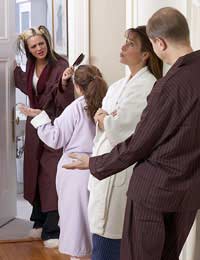Candid Portraits

So-called ‘candid’ photography is one of the most widely practiced photographic genres and possibly the area in which the greatest photographs have been taken. Henri Cartier-Bresson is often said to be the absolute master of the candid photograph, capturing what he called the ‘decisive moment’.
Indeed, the decisive moment is the key to candid photography. This is the moment in which all of the elements required to create a great photograph out of an interesting scene come together in front of the lens. The decisive moment, as Cartier-Bresson outlined in his book of the same name, is the moment which occurs in every situation in which everything that needs to be said about that scene is visually evident and ready to be photographed. Capturing this moment can be difficult; this is the key to candid photography.
Equipment
The great masters of candid photography have all tended to use very similar equipment. Whether they articulated it in the same way as Cartier-Bresson or not, all candid photographers have been trying to capture the decisive moment, and in order to do this it is necessary to ensure that the act of taking the photograph does not obstruct the natural course of the events which the photographer is trying to capture. As a result, candid photographers tend to use small, unobtrusive cameras. Cartier-Bresson, for example, favoured a small 35mm Leica, while more recently Lomo enthusiasts have been using tiny Russian cameras with very wide lenses. In order to counter the width of the lens, these photographers are often required to get very close to the subjects of their photographs. This proximity is important, as it often allows the viewer to establish more of an emotional connection with the subjects through a feeling that they are, in fact, part of the action.Manipulation and Editing
When attempting to capture good candid images, you shouldn’t be afraid to shoot a lot of images. Photographers like Annie Liebowitz have often said that they could shoot rolls and rolls of film in order to get that one great image, and there is no reason why you should not do the same – particularly if you have the economic advantage of a digital camera.If you are shooting digital, however, you should also remember that one of the most important premises of the candid image is that it is presented to the viewer exactly as it occurred; manipulation, either in the darkroom or in Photoshop, tends to be frowned upon if it in any way gives a false impression of the scene and the action within it. That is not to say, of course, that you should be scared to perform tasks like, for example, slightly enhancing the contrast or correctly white balancing your images, but anything beyond this should be viewed with caution.
Candid photography is about attempting to provide a truthful representation of the world as the photographer sees it; a close proximity to the action, an unobtrusive method and an honest final image are the key components required to achieve this aim.


Re: Photography Copyright Law
Hello, My name is Kimberly Wood and I run a business selling movie DVDs, and Blue-Rays. Both music and movies for me have always…
Re: Storing Your Photos Online
Flickr is fine just as a photo site, but plenty of people put pictures in albums on Facebook, for example, which is one way to store…
Re: Developing Your Own Film and Darkroom Basics
Hi, Please send me the details of new set up of digital color lab and having any expenses and cost of…
Re: What is the Copyright on Old Photographs to Use as Calendars?
Hi, I have an old photograph I got at a flea market, (a snapshot) that I want to use…